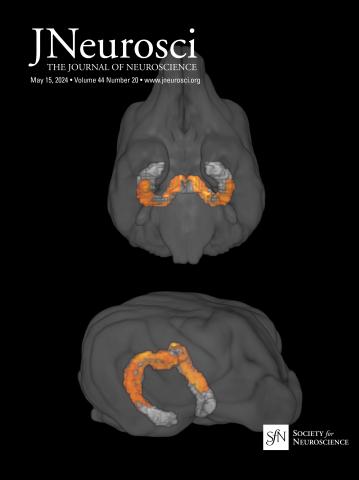The anterior insula processes a time-resolved subjective risk prediction error.
IF 4.4
2区 医学
Q1 NEUROSCIENCES
引用次数: 0
Abstract
The insula processes errors in the prediction of risky, motivationally relevant outcomes, and thereby is thought to respond similarly to better than predicted and worse than predicted outcomes. However, the nature of the encoded risk prediction error signals remained unclear. Moreover, the insula was proposed to preferentially process events and stimuli in the aversive domain, rather than in a domain-general fashion. Here we aimed to illuminate these issues. Within a Pavlovian task, participants (n=41; 19 women) rated both cues and outcomes, allowing us to quantify not only objective but also trial-specific subjective risk prediction errors. We found preferential coding of subjective risk prediction errors in the anterior insula and adjacent frontal cortex. This contrasted with preferential coding of objective risk prediction errors in the mid-insula. The anterior insula encoded the subjective risk prediction errors not only at the time of outcomes, but also at the time of cues, in-line with a temporally fine-grained computation of these prediction errors. Cue-induced subjective risk prediction error signals occurred predominantly in the aversive domain, while outcome-induced subjective risk prediction error signals occurred also in the appetitive domain. Domain-specific analyses of risk prediction errors elicited by the preceding outcome at the time of the next cue indicated that the anterior insula updates risk predictions more strongly in the aversive than the appetitive domain. Together, our findings specify the nature of risk prediction errors processed by the anterior insula as subjective, time-resolved, and partly domain-general (outcome), partly domain-preferential (cue), thereby reconciling apparently disparate lines of research.Significant Statement The anterior insula is a hub of the salience network, thought to process both good and bad surprises. However, salience needs defining and the nature of salience signals in anterior insula remained unclear. Here, we define salience as risk and use a Pavlovian task with subjectively evaluated cues and liquid outcomes, allowing us to determine unsigned surprise, i.e., risk prediction errors, at both time points. In a double dissociation, subjective risk prediction error signals occurred preferentially in anterior insula and objective signals in mid-insula. We also show that subjective risk prediction errors are preferentially encoded for aversive rather than appetitive cues. These findings unify divergent frameworks of insula function, specifying the insula's nuanced role in salience processing for motivated behavior.脑岛前部处理一个时间解决的主观风险预测误差。
脑岛在预测有风险的、动机相关的结果时处理错误,因此被认为对好于预测和差于预测的结果有相似的反应。然而,编码风险预测误差信号的性质仍不清楚。此外,脑岛被认为优先处理厌恶域的事件和刺激,而不是以域一般的方式。在这里,我们旨在阐明这些问题。在巴甫洛夫任务中,参与者(n=41;19名女性)对线索和结果进行了评分,使我们不仅可以量化客观风险预测误差,还可以量化试验特定的主观风险预测误差。我们发现主观风险预测误差的优先编码存在于脑岛前部和相邻的额叶皮层。这与中脑区客观风险预测误差的优先编码形成对比。前脑岛不仅编码了结果时的主观风险预测误差,也编码了提示时的主观风险预测误差,与这些预测误差的时间细粒度计算一致。提示诱导的主观风险预测误差信号主要出现在厌恶域,结果诱导的主观风险预测误差信号也出现在食欲域。对先前结果在下一次提示时引起的风险预测误差的区域特异性分析表明,前脑岛在厌恶区域比食欲区域更新风险预测的力度更大。总之,我们的研究结果明确了由前脑岛处理的风险预测错误的本质是主观的,时间解决的,部分领域一般(结果),部分领域优先(线索),从而协调了明显不同的研究方向。前脑岛是突出网络的枢纽,被认为处理好的和坏的惊喜。然而,突出信号的性质尚不清楚,需要对突出信号进行定义。在这里,我们将显著性定义为风险,并使用具有主观评估线索和液体结果的巴甫洛夫任务,使我们能够在两个时间点确定无符号惊喜,即风险预测误差。双分离时,主观风险预测误差信号优先出现在脑岛前部,客观信号优先出现在脑岛中部。我们还表明,主观风险预测误差优先编码厌恶而不是食欲线索。这些发现统一了脑岛功能的不同框架,明确了脑岛在动机行为的显著性加工中的微妙作用。
本文章由计算机程序翻译,如有差异,请以英文原文为准。
求助全文
约1分钟内获得全文
求助全文
来源期刊

Journal of Neuroscience
医学-神经科学
CiteScore
9.30
自引率
3.80%
发文量
1164
审稿时长
12 months
期刊介绍:
JNeurosci (ISSN 0270-6474) is an official journal of the Society for Neuroscience. It is published weekly by the Society, fifty weeks a year, one volume a year. JNeurosci publishes papers on a broad range of topics of general interest to those working on the nervous system. Authors now have an Open Choice option for their published articles
 求助内容:
求助内容: 应助结果提醒方式:
应助结果提醒方式:


